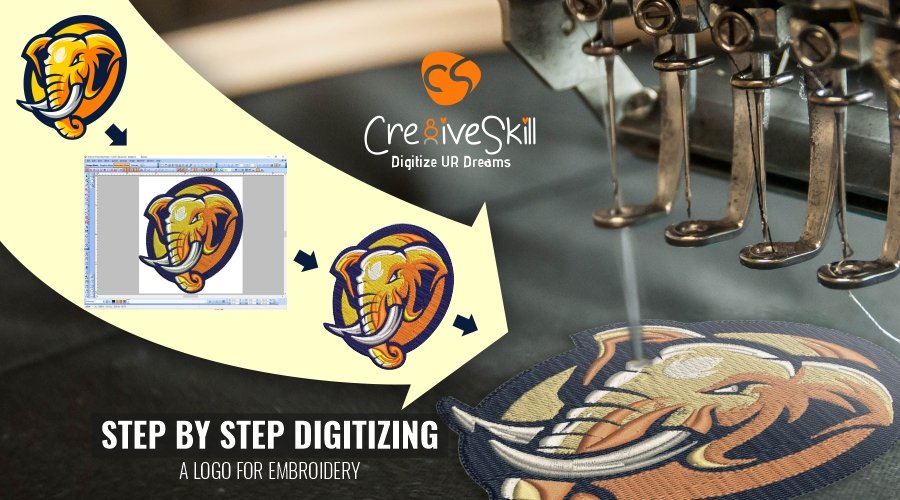Grasping the Needlework Digitizing Refine: Your Ultimate Guide
Embroidery digitizing is a precise craft that calls for precision and experience to equate elaborate designs right into digital styles for machine needlework. As artisans begin on this journey to grasp the embroidery digitizing procedure, an extensive understanding of the basics establishes the foundation for quality. Beyond the rudimentary expertise exists a world of sophisticated software application, specialized devices, and nuanced strategies waiting to be checked out. By diving right into the subtleties of digitizing, one can unlock a globe of creative opportunities and boost their embroidery projects to new heights.

Understanding Embroidery Digitizing Essentials
Embroidery digitizing basics create the structure upon which elaborate layouts are translated into machine-readable formats for exact stitching. This initial action in the needlework digitizing process is vital for making certain that the last embroidered item is a loyal representation of the initial style. Understanding embroidery digitizing basics entails understanding vital ideas such as stitch kinds, sew instructions, density, underlay, and draw compensation.
Stitch kinds play a vital function in identifying the aesthetic and textural outcome of the stitched design. By choosing the appropriate stitch kind, whether it be satin, fill, or running stitch, digitizers can achieve the preferred effect and enhance the general high quality of the embroidery. Furthermore, stitch direction affects the circulation and measurement of the style, while thickness establishes the spacing and protection of the stitches.
In addition, padding sewing supplies security to the design by securing the material and preventing distortion throughout the needlework procedure. Pull payment is one more crucial factor to consider to neutralize the all-natural tendency of fabric to agreement when sewn. Grasping these embroidery digitizing fundamentals is fundamental for creating professional-quality stitched items.
Selecting the Right Digitizing Software
Choosing the suitable digitizing software program is an important decision that considerably influences the performance and high quality of the needlework digitizing procedure. Digitizing for Embroidery. When choosing the appropriate digitizing software application, it is necessary to take into consideration aspects such as the complexity of styles you prepare to develop, the user-friendliness of the software program, the degree of client support provided, and the compatibility with your needlework device
There are different digitizing software options readily available in the marketplace, varying from fundamental programs for newbies to advanced software application for specialist digitizers. Some preferred options consist of Wilcom EmbroideryStudio, Hatch Embroidery Software Program, and PulseID. These software plans supply a large site here range of devices and functions to assist you produce elaborate styles with ease.
Prior to choosing, it is recommended to check out the different software program choices through complimentary trials or trials to figure out which one ideal fits your requirements. Additionally, reading reviews and looking for recommendations pop over to these guys from knowledgeable digitizers can provide valuable insights right into the strengths and weaknesses of each software (Digitizing for Embroidery). By meticulously evaluating your demands and contrasting the attributes of different digitizing software application, you can make an educated option that boosts your needlework digitizing process
Digitizing Tools and Techniques

Optimizing Design Settings for Embroidery
Grasping the intricacies of style setups is basic in achieving optimum outcomes in the embroidery digitizing process, building upon the structure laid by understanding digitizing tools and methods. When enhancing design settings for embroidery, it is important to take into consideration factors such as stitch type, thickness, rug, pull compensation, and registration. Sew type option influences the overall feel and look of the discover here style, with options like satin, fill, and running stitches using various structures and results. Density refers to the spacing and thickness of stitches, impacting the style's protection and resilience. Appropriate rug stitching supplies security and protects against textile distortion, specifically for intricate styles or on stretchy materials. Draw settlement readjusts for material stretch throughout sewing, making certain exact style duplication. Enrollment settings line up various aspects of the layout accurately, preserving general design honesty. By fine-tuning these design setups, embroiderers can boost the high quality and precision of their embroidered creations.

Troubleshooting Common Digitizing Issues
When running into common digitizing concerns throughout the needlework process, it is vital to comprehend the source and carry out reliable remedies without delay. One common trouble is stitch thickness concerns, where stitches might be too dense, creating the textile to tighten, or also thin, bring about spaces in the layout. Changing the stitch thickness setups in the digitizing software can help resolve this concern.
An additional regular difficulty is string breaks during the needlework process. This can take place due to numerous reasons such as inaccurate stress settings, plain needles, or making use of low-grade thread. Ensuring proper maintenance of the needlework equipment, including regular needle adjustments and tension changes, can lessen the event of string breaks.
Additionally, style enrollment errors can cause misaligned elements within the embroidery design. Examining the layout placement in the digitizing software and making needed changes before sewing can aid in avoiding this issue. By dealing with these common digitizing concerns without delay and effectively, you can guarantee a smoother needlework process and high-grade completed products.
Final Thought
In conclusion, grasping the embroidery digitizing procedure calls for a solid understanding of the basics, the best choice of software program, and knowledge of devices and strategies. Maximizing design setups and repairing common digitizing problems are critical actions in making sure premium embroidery results. By following these steps vigilantly, one can achieve precision and efficiency in the digitizing procedure.